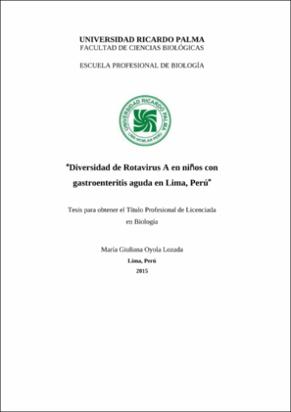| dc.contributor.author | Oyola Lozada, María Giuliana | |
| dc.date.accessioned | 2016-08-01T19:12:50Z | |
| dc.date.available | 2016-08-01T19:12:50Z | |
| dc.date.issued | 2015 | |
| dc.identifier.uri | https://hdl.handle.net/20.500.14138/590 | |
| dc.description.abstract | La gastroenteritis ocasionada por rotavirus se encuentra entre las principales causas de morbilidad y mortalidad infantil. En el Perú rotavirus representa el 30% de las muertes por diarrea y 4% del total de defunciones, afectando principalmente a niños menores de 5 años. Desde el año 2009 el Perú implementó la vacuna contra rotavirus en su programa de vacunación universal, sin embargo, debido a la aparición de genotipos emergentes, es importante monitorear la diversidad del virus para evaluar los posibles efectos sobre la eficacia de la vacuna. Pese a esto, existen escasos reportes de la epidemiología de rotavirus en nuestro país. El objetivo del presente estudio es determinar la presencia y los genotipos G y P de Rotavirus en muestras provenientes de niños con gastroenteritis aguda atendidos en un hospital de Lima entre Octubre del 2013 y Octubre del 2014. Como metodología se utilizó el RT-PCR en tiempo real (qRT- PCR) para la detección del rotavirus y el RT PCR convencional para la genotipificación de las muestras positivas, asimismo se secuenciaron algunas muestras para determinar los genotipos finales. De las 448 muestras analizadas en el estudio, 45 (10%) tuvieron resultado positivo para rotavirus. Entre los genotipos identificados, G12 (40.9%), G2 (25%) y P[8] (77.3%) fueron los más frecuentes y la combinación G/P más dominante fue G12P[8] (54.5%). Los resultados evidenciaron una alta prevalencia de G12P[8]entre los casos positivos, genotipo no reportado previamente en el Perú. Se recomienda realizar nuevos estudios para evaluar las variaciones en la diversidad de rotavirus circulantes en el Perú y los posibles efectos ante la presión selectiva de la vacuna.Rotavirus gastroenteritis is one of the leading causes of morbidity and mortality in children. In Peru rotavirus represents 30% of deaths due to diarrhea and is responsible of 4% of the total deaths, affecting mostly children under 5 years. Peru implemented the rotavirus vaccine in its universal vaccination program since 2009. Due to the appearance of emerging genotypes, it is important to evaluate the diversity of the virus in order to determine possible effects on vaccine efficacy. However there are few reports on the molecular epidemiology of rotavirus in our country. The aim of this study was to determine the presence and Rotavirus G and P genotypes in samples from children with acute gastroenteritis attended in a hospital in Lima between October 2013 and October 2014. The method usedfor the detection of rotavirus was real time RT-PCR (qPCR) and conventional RT-PCR to determine the genotype of positive samples. Additionally, sequencing was used to confirm the final genotype of some samples. Of the 448 samples analyzed, 45 (10%) were positive for rotavirus.G12 (40.9%), G2 (25%) and P[8] (77.3%) were the most frequent genotypes and the most prevalent G/P combination was G12P[8] (54.5%). The results showed a high prevalence of G12P[8] among the positive cases. G12P[8] has not been previously reported in Peru. We recommend more in deep studies to identify the diversity of circulating genotypes in Peru. | es_ES |
| dc.description.sponsorship | Submitted by Wong Rafael (rafel_wl@hotmail.com) on 2016-08-01T19:12:50Z
No. of bitstreams: 1
oyola_mg.pdf: 1698532 bytes, checksum: 832edd750141eef6be252d0d32ddcd33 (MD5) | es_ES |
| dc.description.sponsorship | Made available in DSpace on 2016-08-01T19:12:50Z (GMT). No. of bitstreams: 1
oyola_mg.pdf: 1698532 bytes, checksum: 832edd750141eef6be252d0d32ddcd33 (MD5)
Previous issue date: 2015 | es_ES |
| dc.description.sponsorship | Restored into DSpace on 2016-12-07T20:39:31Z (GMT). | es_ES |
| dc.description.uri | Tesis | es_ES |
| dc.format | application/pdf | |
| dc.language.iso | spa | |
| dc.publisher | Universidad Ricardo Palma - URP | es_ES |
| dc.rights | info:eu-repo/semantics/openAccess | |
| dc.rights.uri | https://creativecommons.org/licenses/by-nc-nd/4.0/ | |
| dc.source | Repositorio Institucional - URP | es_ES |
| dc.subject | Gastroenteritis aguda | es_ES |
| dc.subject | Rotavirus | es_ES |
| dc.subject | Perú | es_ES |
| dc.subject | Genotipos Virales | es_ES |
| dc.subject | Acute gastroenteritis | es_ES |
| dc.subject | viral genotypes | es_ES |
| dc.title | Diversidad de Rotavirus A en niños con gastroenteritis aguda en Lima-Perú | es_ES |
| dc.type | info:eu-repo/semantics/bachelorThesis | |
| thesis.degree.discipline | Biología | es_ES |
| thesis.degree.grantor | Universidad Ricardo Palma. Facultad de Ciencias Biológicas. Escuela Profesional de Biología | es_ES |
| thesis.degree.level | Título Profesional | es_ES |
| thesis.degree.name | Licenciado en Biología | es_ES |
| dc.publisher.country | PE | es_ES |
| renati.type | https://purl.org/pe-repo/renati/type#tesis | |
| renati.level | https://purl.org/pe-repo/renati/nivel#tituloProfesional | |
| renati.discipline | 511206 | |
| dc.type.version | info:eu-repo/semantics/publishedVersion | |


